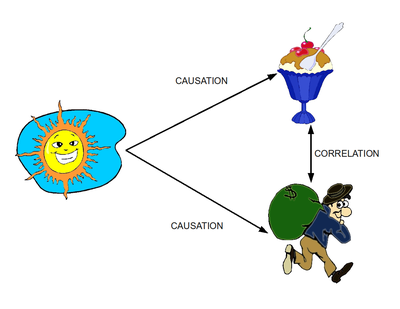Correlation
Correlation (co-relation) refers to the degree of relationship (or dependency) between two variables.
Linear correlation refers to straight-line relationships between two variables.
A correlation can range between -1 (perfect negative relationship) and +1 (perfect positive relationship), with 0 indicating no straight-line relationship.
The earliest known use of correlation was in the late 19th century[1].
Introduction
When we ask questions such as "Is X related to Y?", "Does X predict Y?", and "Does X account for Y"?, we are interested in measuring and better understanding the relationship between two variables.
Correlation measures the extent to which variables:
- covary
- depend on one another
- predict one another
The extent of correlation between two variables, by convention, is denoted r, and the correlation between variable X and variable Y is indicated by rXY.
Correlations are standardised to vary between -1 and +1, with 0 representing no relationship, -1 a perfect negative relationship, and +1 a perfect positive relationship.
A variety of bivariate correlational statistics are available, the choice of which depends on the variables' level of measurement:
- Nominal by nominal: Contingency table, Pearson's chi-square test, Phi/Cramer's V
- Ordinal by ordinal: Spearman's rho, Kendall's tau-b
- Dichotomous by interval/ratio: Point biserial correlation coefficient
- Interval/ration by interval/ratio: Pearson product-moment correlation coefficient
Correlational analyses should be accompanied by appropriate bivariate graphs, such as:
- Nominal by nominal: Clustered bar charts
- Ordinal by ordinal: Scatterplot (with point bins)
- Interval/ratio by interval/ratio: Scatterplot
The world is made of covariation
Responses which vary can be measured as a variable (i.e., responses are distributed across a range).
Responses to two or more variables may covary. These variables share some variation. When the value of one variable is high, the value of other variable tends to be high (positive correlation) or low (negative correlation).
If you look around, you may notice that the world is made of covariation! e.g.,
- pollen count is positively correlated with bee activity
- rainfall is positively correlated with amount of vegetation
- hours of study is positively correlated with test performance
- number of fire trucks attending a fire is correlated with cost of repairs for the fire[2]
- Sibling's IQ is positively correlated
- air temperature is negatively correlated with amount of clothing worn
The more you look, the more you'll see that there are many predictable patterns of co-occurrence between phenomena (i.e., things tend to occur together).
Scatterplots[edit]
Independent variable (IV) (predictor) is placed on the X axis and dependent variable (DV) is placed on the Y axis. Each case is plotted according to its X and Y value.
r = .76
Visual inspection of scatterplots is essential[edit]
It is unwise to rely solely on correlation as a statistic that indicates the nature of the relationship between variables without also examining a visualisation of the data such as through a scatterplot.
For example, the linear (straight-line) correlation in each of these four scatterplots is .82, yet the nature of what the data indicated about the relationship between the variables is very different for each.
Four sets of data with the same correlation of 0.816
| You can help expand this section. |
Correlation does not equal causation
[http://www.burns.com/wcbspurcorl.htm Spurious correlations]
| You can help expand this section. |
See Correlation does imply causation (Wikipedia)
Range restrictio
Pearson/Spearman correlation coefficients between X and Y are shown when the two variables' ranges are unrestricted, and when the range of X is restricted to the interval (0,1).
| You can help expand this section. |
See outliers and restricted range
(출처 : http://en.wikiversity.org/wiki/Correlation)
'Articles (Etc)' 카테고리의 다른 글
| 미래의 의료기술 (Envisioning the Future of Health Technology) - 증폭, 재생, 진단, 원격의료, 생물노인학, 치료 (0) | 2013.07.04 |
|---|---|
| 의사가 되고자 하는 사람들에게 - 새로운 방식의 인성 면접 (New for Aspiring Doctors, the People Skills Test) (0) | 2013.07.01 |
| 확증 편향(Confirmation bias) : 어떤 것이 옳다고 믿는 신념을 더 강화하려는 우리의 행동패턴. (0) | 2013.06.28 |
| 자기 고양적 편견(self serving bias) (0) | 2013.06.28 |
| Focus Group Interview(FGI, 포커스 그룹 인터뷰)와 데이터 분석 (2) : 데이터 분석 (0) | 2013.06.27 |




